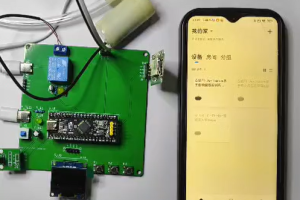设计说明书
总字数:15000+
摘要
随着农业现代化进程加快,农田灌溉的精准性与高效性愈发关键。传统灌溉方式多依赖人工经验判断,存在浇水时机不准、水量控制粗放的问题 —— 土壤过干易导致作物缺水减产,过湿则引发根系腐烂,同时人工巡检成本高、响应滞后,难以适配大规模农田管理需求。此外,水资源短缺问题日益突出,传统漫灌式灌溉水资源利用率不足 50%,严重制约农业可持续发展。因此,研发一款能实时监测环境与土壤状态、自动调控灌溉、支持远程管理的单片机灌溉控制系统,对提升作物产量、节约水资源、降低管理成本具有重要现实意义。
本设计提出了一种基于 STM32F103C8T6 单片机的农田自动灌溉控制系统。系统主要功能包括:通过 DS18B20 温度检测模块实时采集农田环境温度;借助 YL69 土壤湿度检测模块获取土壤湿度值,当湿度小于设置最小值时,自动驱动继电器启动灌溉设备,直至湿度大于设置最大值后停止;支持通过按键现场设置土壤湿度上下限值,也可在湿度处于正常区间时手动控制灌溉;通过 OLED 液晶显示屏实时展示环境温度、土壤湿度及灌溉状态;依托 ESP8266-12F WIFI 模块,将检测数据远程传输至手机端,用户可在手机上查看实时温湿度,也能远程发送指令控制灌溉设备启停,实现 “自动 + 远程” 双重管控。
该农田自动灌溉控制系统的作用在于,为农田灌溉提供了一种精准、智能、便捷的解决方案。通过实时监测与自动调控,确保土壤湿度始终处于作物适宜范围,提升作物生长质量;远程管理功能减少人工巡检工作量,降低管理成本;精准控水设计可将水资源利用率提升至 80% 以上,有效节约水资源,助力农业绿色可持续发展。
关键词:单片机;农田自动灌溉控制系统;土壤湿度检测;远程控制;精准灌溉
Design of Automatic Irrigation Control System for Farmland
Abstract
With the acceleration of agricultural modernization, the precision and efficiency of farmland irrigation have become increasingly crucial. Traditional irrigation methods rely heavily on manual experience judgment, which leads to problems such as inaccurate watering timing and extensive water control – excessively dry soil can easily cause crop water shortage and yield reduction, while excessively wet soil can lead to root rot. At the same time, manual inspection costs are high and response is lagging, making it difficult to adapt to large-scale farmland management needs. In addition, the problem of water scarcity is becoming increasingly prominent, and the utilization rate of water resources in traditional flood irrigation is less than 50%, which seriously restricts the sustainable development of agriculture. Therefore, developing a single-chip irrigation control system that can monitor the environment and soil conditions in real time, automatically regulate irrigation, and support remote management is of great practical significance for improving crop yields, saving water resources, and reducing management costs.
This design proposes an automatic irrigation control system for farmland based on STM32F103C8T6 microcontroller. The main functions of the system include: real-time collection of farmland environmental temperature through DS18B20 temperature detection module; Using the YL69 soil moisture detection module to obtain soil moisture values, when the humidity is less than the set minimum value, the relay is automatically driven to start the irrigation equipment until the humidity is greater than the set maximum value and then stops; Support setting the upper and lower limits of soil moisture on-site through buttons, and can also manually control irrigation when the humidity is within the normal range; Real time display of environmental temperature, soil moisture, and irrigation status through OLED LCD screen; Relying on the ESP8266-12F WIFI module, the detection data is remotely transmitted to the mobile phone. Users can view real-time temperature and humidity on their phones, and also remotely send instructions to control the start and stop of irrigation equipment, achieving dual control of “automatic+remote”.
The function of this automatic irrigation control system for farmland is to provide a precise, intelligent, and convenient solution for farmland irrigation. By real-time monitoring and automatic regulation, ensure that soil moisture is always within the suitable range for crops and improve crop growth quality; The remote management function reduces the workload of manual inspections and lowers management costs; Accurate water control design can increase the utilization rate of water resources to over 80%, effectively saving water resources and promoting green and sustainable development of agriculture.
Keywords:microcontroller; Automatic irrigation control system for farmland; Soil moisture detection; Remote control; precision irrigation
目 录
1 绪论
1.1 研究背景及意义
1.2 国内外研究现状
1.3 主要内容
2 系统总体方案设计
2.1系统总体设计
2.2 主要模块方案选择
3 系统硬件设计
3.1 总体硬件框架
3.2 主控模块电路设计
3.3 温度检测模块电路设计
3.4 土壤湿度检测模块电路设计
3.5 继电器控制模块电路设计
3.6 按键模块电路设计
3.7 显示模块电路设计
3.8 WIFI 通信模块电路设计
4 系统程序设计
4.1 编程软件介绍
4.2 系统主流程设计
4.3 温度检测模块子流程设计
4.4 土壤湿度检测模块子流程设计
4.5 独立按键
4.6 OLED显示流程设计
4.7 WiFi模块子流程设计
5 实物制作与功能测试
5.1 实物制作
5.2 温湿度检测与 OLED 显示功能测试
5.3 土壤湿度控制与继电器灌溉功能测试
5.4 按键阈值设置功能测试
5.5 WIFI 远程监测与控制功能测试
6 总结
参考文献
致谢
附录A 原理图
附录B PCB
附录C 主程序

